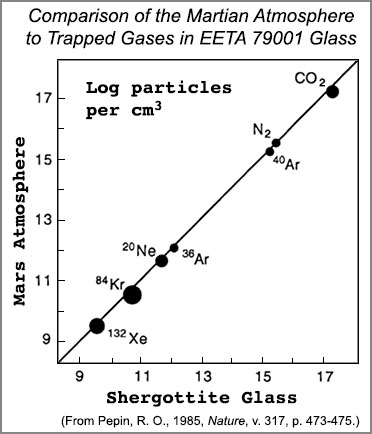|
 |
|
 |
|
 |
An examination of ALH 84001 believed to be from Mars shows: 1) hydrocarbons which are the same as breakdown products of dead micro-organisms on Earth, 2) mineral phases consistent with by-products of bacterial activity, and 3) tiny carbonate globules which may be microfossils of the primitive bacteria, all within a few hundred-thousandths of an inch of each other.



The suggestion for life hinges on three important pieces of evidence, all discovered within mineralized fractures in the meteorite in close proximity to each other. One is the discovery of abundant polycyclic aromatic hydrocarbons (PAHs) on the fracture surfaces. These are a family of complex organic molecules which are commonly found on dust grains and certain types of meteorites in outer space, presumably formed by non-biological chemical reactions. However, when micro-organisms die they break down into PAHs as well. The mixture of PAHs found on ALH84001 is very different from that found on dust grains and other meteorites, suggesting the possibility of a biological origin. Thousands of different types of PAHs are found all over the Earth, but those in ALH84001 do not appear to be contaminants which have leaked into the meteorite. Another line of evidence involves unusual mineral phases found beside the PAHs. These carbonate minerals form "globules" about 50 micrometers across, some of which have cores containing manganese and rings of iron carbonate and iron sulfides, and also contain magnetite and pyrrhotite. These minerals bear strong resemblance to mineral alterations caused by primitive bacteria on Earth. This diversity of minerals in such a small area, formed under the presumed conditions, seem to make a non-biological origin unlikely. Their ages are uncertain, estimates ranging from 1.2 to 4 billion years. High-resolution scanning electron microscopy has revealed the presence of tiny "ovoids" which may actually be fossil remnants of tiny (20 to 100 nanometer) bacteria. If so, they are 100 times smaller than any bacteria microfossils found on Earth, except for some supposed "nanofossils" recently discovered in very young terrestrial rocks, a finding currently not generally accepted as fossil organisms.
Caveat.
First, chemical analysis showed that the meteorite contained a
variety of organic molecules known as polycyclic aromatic hydrocarbons
or PAHs. PAHs can be produced by biological processes, and that's what
McKay and his colleagues argued. But they are also commonly found in
asteroids, comets and meteorites, not to mention the Antarctic ice
where ALH84001 is estimated to have lain for 13,000 years.
Another line of evidence that has survived longer is one that revolves around minerals sprinkled through the meteorite that could have been produced by microbes, magnetite and carbonate. The second mineral, carbonate , is typically formed on earth by the remains of living organisms that make shells and other skeletal parts out of minerals they extract from seawater. Some of those organisms can be quite tiny. So finding carbonate in ALH84001 could indicate the presence of ancient microbes in the rock.


The story is similar for magnetite , the other mineral of interest in ALH84001. Some bacteria produce extraordinarily small and pure magnetite crystals, then align the magnetic grains to make a microscopic compass needle that helps them navigate. The bacteria don't use their internal compasses to find north; they use them to tell up from down. Earth's spherical shape means that a compass needle in either hemisphere points at least somewhat downward, so the magnetite grains help the microbes sense where they are with respect to the planet's surface. Some of the most evolutionarily ancient bacteria on Earth produce magnetite, McKay and his colleagues pointed out. Perhaps ancient Martian microbes did as well; at least some of the magnetite grains in ALH84001 share the shape, small size and remarkable purity of those produced by bacteria on Earth. Of all the lines of evidence presented by the NASA scientists, magnetite grains are the most provocative. They were embedded in the carbonate along with other iron-containing minerals in such an unusual arrangement that something out of the ordinary must have put them there could it have been alive? |